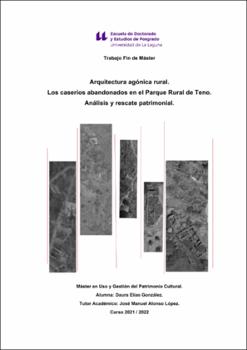Arquitectura agónica rural. Los caseríos abandonados en el Parque Rural de Teno. Análisis y rescate patrimonial.
Author
Elías González, DauraDate
2023Abstract
El objetivo de este trabajo es poner en valor la arquitectura agónica en el medio rural,
en concreto en el Parque Rural de Teno. En esta zona la decadencia y pérdida del
cultivo del cereal, ha hecho que estos vestigios de arquitectura estén abandonados y
en muy mal estado de conservación, debido a la situación de desinterés que sufren
desde el ámbito cultural. Mediante esta propuesta, aplicando la metodología de trabajo
expuesta y los conocimientos adquiridos durante el trascurso del Máster, se tratará de
buscar mediante un análisis de los casos propuestos, respuesta al desinterés que
padecen. De este modo, se podrá ofrecer una puesta en valor del patrimonio
construido en el medio rural, con un proyecto viable, sostenible y poco invasivo de
difusión y rescate, que contribuya a que este patrimonio que agoniza no desaparezca
por completo. La arquitectura rural en Canarias es quizás por la que se muestra
menos interés. Se puede pensar de manera equivocada que no aporta al Patrimonio
cultural lo mismo que la arquitectura urbana, lo cual está en lo cierto y debe de
diferenciarse. Igualmente, se debe estudiar y poner en valor desde la Gestión Cultural,
ya que da un testimonio fiel del modo de vida en un lugar concreto del territorio, lo que demuestra la singularidad patrimonial de lo construido en el medio rural. The aim of this work is to highlight the value of the agonic architecture in the rural
environment, specifically in the Teno Rural Park. In this area, the decline and loss of
cereal cultivation has meant that these architectural remains have been abandoned
and are in a very poor state of conservation, due to the lack of interest in them from the
cultural point of view. By means of this proposal, applying the work methodology
described above and the knowledge acquired during the course of the Master's degree,
the aim will be to seek, through an analysis of the proposed cases, a response to the
lack of interest they suffer.
In this way, it will be possible to offer an enhancement of the value of the built heritage
in rural areas, with a viable, sustainable, and minimally invasive project of
dissemination and rescue, which will help to ensure that this dying heritage does not
disappear completely. Rural architecture in the Canary Islands is perhaps the one in
which the least interest is shown. It can be mistakenly thought that it does not
contribute to cultural heritage in the same way as urban architecture, which is correct
and should be differentiated. Likewise, it should be studied and valued from the
perspective of Cultural Management, as it provides a faithful testimony of the way of life
in a specific place in the territory, which demonstrates the singularity of the heritage built in the rural environment.





